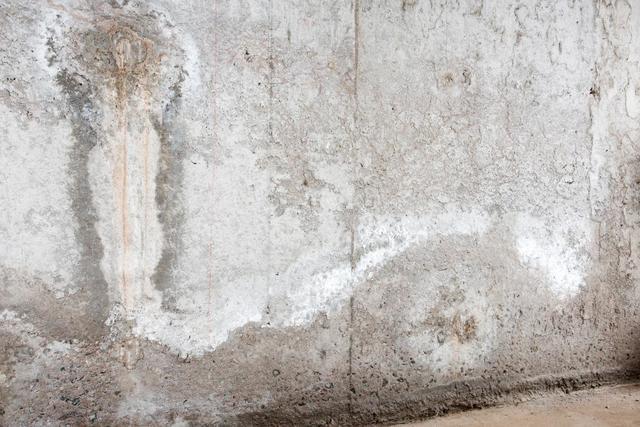What's That White Stuff On My Basement Walls?

You might notice white stains randomly appear if you have bare concrete or block walls in your basement. It’s white and powdery. Almost chalk-like.
The white stain is called efflorescence. And it’s a residue left from water.
But what exactly is it? And why did it randomly show up? Is it preventable? We go over all of this and more in this blog post. Let’s go.
What is efflorescence?
Efflorescence is the deposit of salts left on masonry after the water evaporates. It appears on surfaces like concrete, retaining walls, stone, and stucco.

Efflorescence is not mold, toxic, or hazardous in any way. It does, however, indicate there has been water in your basement.
How does it form?
Efflorescence requires three main components to form:
1. Salt. Your wall needs to have some sort of water-soluble salt on it for efflorescence to form.
At this point, you’re probably like, “Uh, why would my wall have salt on it?”
Don’t worry; it’s completely normal. The materials used to build walls, like concrete or stone, are made from natural materials from the earth. Natural materials contain a lot of minerals, salt being one of them.
2. Water. When water meets your salty concrete wall, science happens. The water dissolves the salt on your wall. But eventually, that water evaporates and moves the minerals and salts to the surface. The minerals crystalize and turn into efflorescence.
3. An entry point Finally, water needs to find its way in for efflorescence to even happen.
Wall cracks, foundation cracks, pores in the concrete, and even joints can create an entry point. Wherever efflorescence forms is where the water is leaking from.
Does this mean you have a basement water problem?
Efflorescence on your basement walls is an obvious sign moisture was in your basement.

But to know if you have a basement water problem, you need to find out what type of efflorescence it was: primary or secondary.
Primary efflorescence occurs when too much water is in the concrete mix during manufacturing. Too much water creates moisture that eventually has to work its way to the surface.
Secondary efflorescence comes from an outside source of water. Rain, groundwater, or seepage travels into the concrete and pulls the salt back to the surface.
The best way to know what type of efflorescence is on your walls is to clean it up first. If it doesn’t return, then the cause was the excess water from when the concrete was initially mixed.

But if it does return, you have secondary efflorescence and now know there is some type of water problem in your home.
How to clean
Since efflorescence is just crystalized salt, it’s relatively easy to clean and remove.
The best ways to remove efflorescence:
- Pressure wash. Applying pressurized water will dissolve the efflorescence. Just make sure to dry off the water from your wall after so it doesn’t reappear.
- Diluted vinegar. You can easily make a cleaning solution with everyday items you have in your home. Vinegar and water will be a quick fix that doesn’t require harsh chemicals.
- Brush it off. With a dense brush, efflorescence easily wipes off.
How to fix and prevent efflorescence
Unfortunately, cleaning efflorescence is only a temporary solution.
Water will still travel through that initial entry point, and the efflorescence will return. To eradicate it completely, you first need to find where the water is coming from.

One of the first things to do is scope out the exterior of your home. Take a walk and look for any issues that might unintentionally direct water to your foundation walls.
Ask yourself:
- Are your sprinklers aimed away from your house?
- Are your gutters clear of any debris?
- Are your downspouts several feet away from your home?
If you find no issues, the next thing to do is inspect your home’s drainage system. Is your French drain clogged? Is your sump pump working properly? Do you have a vapor barrier installed?

If you’re still unsure of the water source after inspecting your home, the next action plan is to schedule a foundation inspection. The most common reason for seepage comes from cracks in the foundation.
Schedule a foundation inspection today
Efflorescence is often viewed as harmless. It’s not mold, not toxic, and can easily be wiped off. But ignored efflorescence can turn into a foundation problem.

Efflorescence is the biggest sign of a leak in your foundation or basement walls. If it's not addressed, water will still find its way into your home and could result in cracking and extreme wall failure.
It’s important to address the issue as soon as possible to figure out how severe the water damage is.

At Thrasher Foundation Repair, we offer a free inspection of your home and get to the root of the problem. Upon inspection, we examine the location of the efflorescence, check for all water sources, including drains and pipes, inspect your foundation for cracks, and then propose a long-lasting solution to eradicate water damage.
Please call 1-800-827-0702 or reach out to us online to schedule a free, no-obligation estimate.
Article Categories:



